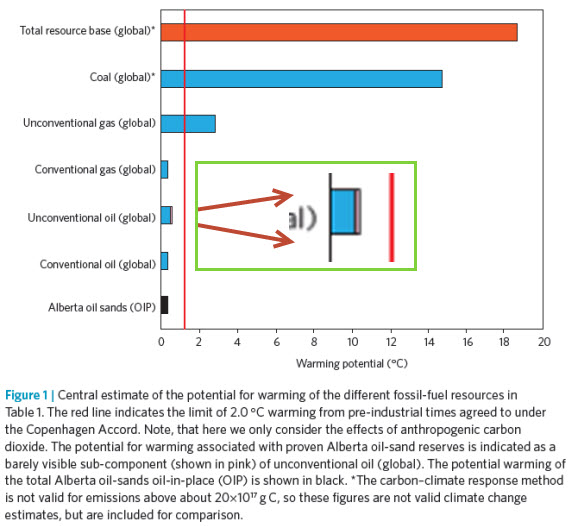
*The climate effects of bitumen development are significant once viewed in the perspective of probable emissions over the rest of this century.
*The climate impact of coal consumption is greater than that of bitumen, particularly when non-mineable coal is considered.
*Accelerated expansion of bitumen extraction will make climate mitigation efforts much more difficult.
*Because of its high carbon emissions and high extraction costs, further bitumen development would not be viable if stringent global emissions policies were adopted.
The accelerating development of the huge bitumen* resources in Alberta has produced a great deal of recent public interest, due mainly to controversial proposals to build two big new pipelines: one connecting Alberta to the US Gulf Coast (Keystone XL) and the other to the Pacific coast of British Columbia (Northern Gateway). Much of the discussion has revolved around the dangers of leaks from the pipelines themselves and, in the case of the Northern Gateway proposal, the risks of tanker accidents in the narrow fjords of BC’s pristine northern coast and the turbulent Hecate Strait. Recent publications have also drawn attention to the massive damage to peatlands caused by bitumen mines and to the pollution of the Athabasca River. However, for the purposes of this article, I will focus only on the effect of bitumen sand exploitation on climate change.
The general topic was discussed previously at Skeptical Science in Tar Sands Impact on Climate Change.
A recent Commentary article in Nature Climate Change by Neil Swart and Andrew Weaver of the University of Victoria (SW12, main paper is subscription only, supplementary information is free access) compared estimates of the potential for global warming caused by bitumen sands to those from other fossil-fuel resources. They showed that the "established resources” (a category similar but not identical to proven reserves) of the Alberta bitumen deposits are small relative to estimates of the total resource base of coal and unconventional gas. Swart and Weaver were careful to state that their results did not in any way provide a free pass to the bitumen industry with regards to carbon emissions. Their concluding paragraph reads:
If North American and international policymakers wish to limit global warming to less than 2°C they will clearly need to put in place measures that ensure a rapid transition of global energy systems to non-greenhouse-gas-emitting sources, while avoiding commitments to new infrastructure supporting dependence on fossil fuels.
Nevertheless, some journalists in Canada and elsewhere have misinterpreted the paper to mean:
In their paper, Swart and Weaver conclude the impact of burning all the economically viable proven reserve of Alberta’s oilsands — all 170 billion barrels — would be negligible.
And, from the same article:
That’s a stark contrast to the claims of those such as NASA climate scientist James Hansen, a leading opponent of the Keystone XL pipeline, who described Alberta’s oilsands as “the biggest carbon bomb on the planet.”
Another headline reads: Coal, not oil sands, the true climate change bad guy, analysis shows.
So what will the consequences of the development of Alberta’s bitumen resources be: “negligible” or “the biggest carbon bomb on the planet”?
The answer, I argue here, is: neither.

Figure 1, from Swart and Weaver (2012). The green box has been added here to better illustrate the “barely visible” contribution (in pink) of remaining established resources of bitumen.
SW12 relied on three main references for their resource estimates. Two are freely available: BP’s Statistical Review of World Energy (spreadsheet) and the 2011 report from Alberta’s ERCB. The third resource, Chapter 7 of the Global Energy Assessment, is in press and will not be publicly available until June 2012 (I have been unable to access a copy of this last source and will update this article later, if required).
The resource estimates were converted to the mass of carbon emitted when combusted, using standard factors detailed in the Supplementary Information. The carbon emissions were transformed into “warming potential” in degrees Celsius, using the methodology of Matthews et al (2009). This method estimates the amount of global warming from the cumulative mass of carbon emissions by means of the simple formula:
ΔT = C × CCR
where ΔT is the increase in temperature, measured in degrees Celsius; C is the cumulative mass of carbon emitted, measured in trillions of tonnes of carbon (TtC); and CCR is the “carbon climate response”. The CCR value used was 1.5 °C/TtC with a 5th to 95th percentile range of 1.0-2.1. These values were derived from historical observations over the twentieth century. [Added: there is a clear explanation of this method at the blog ClimateSight.] The temperature contributions of the various resource estimates are plotted in Figure 1 and, at the scale of this figure, the warming effect of the bitumen is indeed "barely visible".
Although Figure 1 appears to implicitly support the “negligible” interpretation, I argue below that this stems from the way that SW12 has framed the comparison of the relative contribution of bitumen to climate change. First, though, let us look at the size of the bitumen carbon bomb, which SW12 have, at least in terms of "potential for warming", overestimated.
Figure 2 shows the resource estimates taken from Alberta’s 2011 ERCB report in 2011, used by SW12. Focus for now on the bitumen columns.
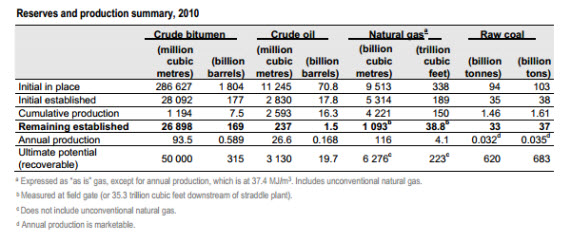
Figure 2. Reserves and resources figures for Alberta’s bitumen, oil, gas and coal. (From page 5 of this ERCB report.) For reference, 1 billion barrels (Gbbl) of bitumen yields 0.13 billion tonnes (Gt) of carbon; 1GT of coal yields ~0.7Gt of carbon.
The initial in-place volumes for bitumen are 1804Gbbl (238GtC), which is equivalent to the black bar (converted to warming potential) for “Alberta oil sands (OIP)” in Figure 1. This estimate was based on detailed mapping of the bitumen reservoirs, using many thousands of wells, as shown in Appendix E of the ERCB report. However, much of the in-place volume will never be recoverable. To cause warming the bitumen, obviously, has to be exhumed and combusted. The ERCB estimate for the ultimate recoverable resource is just 315Gbbl (42GtC), about one-sixth of the in-place volume. However, the fact that this volume is equivalent to the round number of 50,000 million cubic metres suggests that its determination may be arbitrary and, perhaps, conservative with regards to a true ultimate recoverable resource.
Most of the resources outside the “initial established” area will only be accessible by using in-situ methods such as SAGD (i.e., the sands are too deep to mine) and recovery factors for this process are found to be around 50%. The resources outside the "established” area occur in reservoir sands that are thinner and of poorer quality than in the area under active development and would have, using current technology, recovery factors lower than 50%. Even with big improvements in future technology, the in-place numbers (and the ΔT value of 0.36°C) presented by SW12 are higher than any feasible extractable resource, perhaps by a factor of two, and are, in any case, many times higher than the ERCB’s current ultimate potential recoverable estimate. Swart and Weaver are well aware of the in-place/recoverable resource distinction (Neil Swart, personal communication) but they presented the OIP amount and the calculated ΔT values as absolute upper limits.
James Hansen, in a Huffington Post article, cites the IPCC AR4 WGIII report (page 268), which says that Canada’s bitumen resources represent at least 400Gt of “stored carbon” (the reference for this number is not clear). This implies an in-place mass some 68% higher than the ERCB’s in-place estimate and more than nine times the ERCB ultimate recoverable potential resource. The WGIII report states that 310Gbbl (~41GtC) of the bitumen resources are recoverable, a figure close to that of the latest ERCB number of 315Gbbl.
The columns on the right of the table in Figure 2 show the ERCB estimate of ultimate potential recoverable resources of coal of 620Gt (440GtC). This estimate is much larger than the established (mineable) coal resources because it includes seams too deep to mine that, in the future, may be exploitable by in-situ underground coal gasification. Therefore, even using the high IPCC in-place estimate, not only are the bitumen deposits not the biggest carbon bomb on the planet, they may not even be the biggest carbon bomb in Alberta.
The horizontal axis of Figure 1 has been stretched to accommodate the “total resource base” a quantity more than 90% of which derives from combined estimates of global coal and unconventional gas reserves. These vast resource numbers represent many centuries of potential consumption. For example, the global coal resource base (9800GtC) is some 16 times bigger than the current proven reserves of coal (614GtC), which at current consumption levels would last 118 years, according to the BP report. Thus, the global coal resource (the largest blue bar on Figure 1) would, at current rates, take nearly 1900 years to consume.
The global unconventional gas resource base, 1910GtC, of which ~75% comprise methane hydrates (Neil Swart, personal communication), is 18 times the BP proven gas reserves of 107GtC, which has a reserve life of 59 years based on current consumption rates. Therefore, it would take us about 1000 years to burn up these unconventional gas resources at current gas consumption rates. Neither the unproven coal resources nor the gas hydrates are likely to be exploited significantly in this century, because abundant cheaper, proven reserves of coal and gas, as well as shale gas and unconventional oil, are available.
In contrast to the large coal and hydrate gas resources, the proven reserves of oil, gas and coal have already been found and quantified, and are mostly developed. In the majority of economic scenarios these reserves will be mostly consumed over the rest of this century.
Policy decisions currently being made over new pipelines will determine how fast the bitumen resources are developed over a similar time frame. Although it was instructive for SW12 to have placed the bitumen resources in the perspective of all available fossil-fuel resources, it would be perhaps more useful to examine the likely contribution of bitumen consumption to emissions over the remainder of this century. Also, this allows us to compare fossil-fuel resources with established resource bases and proven viable production technologies.
Predicting trends in energy production and consumption is no easy task, depending as it does on a large number of unpredictable economic, regulatory, technological, geological and geopolitical variables. The uncertainty is illustrated in Figure 3, taken from the IPCC SRES study, in which 2100 emissions may be as much as three times 2010 emissions or as little as half, depending on the story line. For the sake of simplicity, I have assumed just two models here: one where all proven fossil fuels are used up by 2100; and another in which 2010 consumption rates for oil, gas and coal are held constant for 90 years.
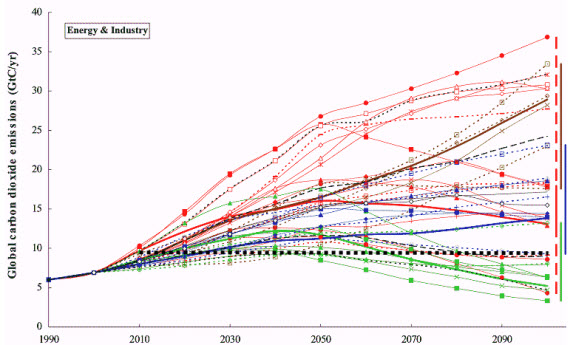
Figure 3. From the IPCC SRES study, Figure 5.2. The lines illustrate annual carbon dioxide emissions (expressed as GtC/yr) for the various scenario families: A1, red; A2, brown; B1, green; B2 blue. The heavy black dotted line has been added to show 2010 emissions held flat for the rest of the century.
Enbridge, the company applying to build the Northern Gateway pipeline, has projected that, by 2035, the supply of diluted bitumen and synthetic crude from Alberta will be 5.8 million barrels per day (bopd). About 20% of this volume will be diluent (lighter crude oils, mostly imported), so that net bitumen production will be about 4.6 million barrels per day; a three-fold increase from 2010 production levels of approximately 1.5 million bopd. If—there are doubts that capital, skilled workers and other resources will be sufficient—this increase can be achieved and if, after 2035, bitumen production continues to increase at a modest rate of 40,000 bopd per year, then the entire established remaining resources of bitumen of 169Gbbl will have been produced by the end of this century.
Bar charts representing the two scenarios are shown in Figure 4. The main difference between the two cases is the relative contribution of coal versus oil and gas. The “proven resources case” would require accelerated coal consumption to make up for exhaustion of the oil and gas resources (perhaps through coal-to-gas or coal-to-liquids technologies) and the “flat consumption case” would require additional resources of gas and oil from new discoveries, reserves growth, and unconventional oil and gas.
The carbon contribution of bitumen has been increased by 17% to account for the extra emissions required. This figure is taken from a note by Swart and Weaver and is based on a paper by Charpentier et al. (2009). SW12 left out this uplift in emissions in their paper because they were looking at the consequences of using the entirety of the fossil-fuel resources and, uplifting the emissions of the bitumen production would have been double counting. However, when we look at this century only, we can include these extra emissions because developing bitumen leads to more demand, especially for gas.
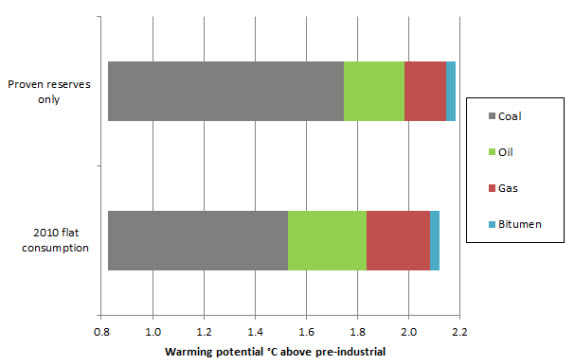
Figure 4. Warming potential (using the same method used in SW12) in 2100, assuming consumption of all proven fossil-fuel reserves (top) and constant consumption of fossil fuels at 2010 rates throughout the rest of the century (bottom). The contribution of the established bitumen resources is shown in blue. The bars are built on a base of 0.825°C warming, calculated using the SW12 methodology, assuming cumulative emissions of 550GtC prior to 2010.
Neither scenario is presented here as a realistic future prediction; the goal is merely to illustrate the relative contribution of bitumen in low-consumption scenarios. In all likelihood, in the absence of policy constraints on fossil-fuel consumption, actual emissions of carbon will be much higher (from coal, shale gas, reserve growth, undiscovered oil and gas and unconventional oil).
In Figure 4, the relative contribution of bitumen to global warming no longer appears “negligible” but neither could it be considered, all by itself, to be catastrophic.
The Carbon Mitigation Initiative of Princeton University writes:
To get on track to avoiding dramatic climate change, the world must avoid emitting about 200 billion tons of carbon, or eight 25 billion ton wedges, over the next 50 years.
The contribution of bitumen consumption to climate change may look insignificant compared to exhuming and burning the world’s entire fossil-fuel resources (Figure 1) and even appears small when placed alongside current proven fossil-fuel reserves, as in Figure 4. However, the carbon that will be emitted as a result of the development of established bitumen resources over the remainder of this century amounts to 22.5GtC (26.1 GtC if the well-to-tank emissions are included), comparable in magnitude— but opposite in sign—to one of the eight Princeton wedges. By consuming Alberta’s bitumen, therefore, we are effectively adding one more wedge on top of the "current path" ramp, increasing the challenge of mitigating climate change by ~12%. This means that we are taking a step closer to the brink, when instead we need to take eight steps back.
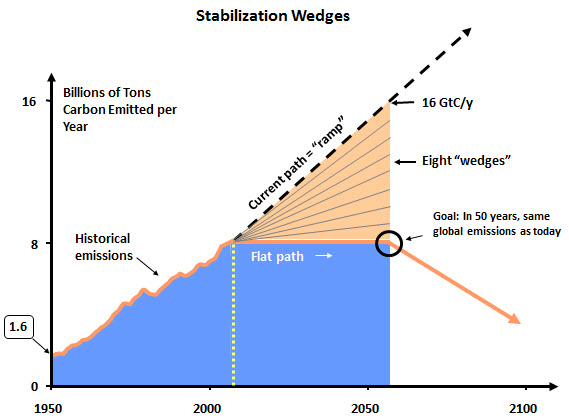
Figure 5. An illustration of the Princeton wedge concept. No single wedge is decisive in combatting climate change, all are needed. Developing Alberta’s bitumen adds a wedge of extra emissions on top of the ramp of the current path. Source. See also the Skeptical Science rebuttal to the myth "It's too hard".
Promoters of Alberta’s bitumen deposits, at least when talking to Canadians (for example), are quick to boast of the wealth that is to be created by their development, referring to the absolute numbers of jobs generated and the positive impact on Canada’s economy. When dealing with the damaging contribution to climate change, their framing switches to a global one, making the emissions from bitumen seem small compared to global emissions, and, referring to SW12's Figure 1, vanishingly small compared to the emissions we might create were we so foolish as to burn the entire massive global resource of coal over a period of many centuries.
Perhaps the tables should be turned on this framing: let’s show how tiny the economic benefits of the bitumen bonanza would be if they were distributed evenly over the whole planet and how utterly insignificant they would be if they were spread over the next several centuries. More practically, let's apply the full environmental costs of bitumen use to those receiving the benefits from producing and consuming the derived fuels.
This is the central tragedy of the climate change problem. The benefits of burning fossil fuels are concentrated on relatively few people and are fleeting, yet the environmental costs are globally dispersed and are spread over millennia. As long as the atmosphere is used as a cost-free dumping-ground by producers and consumers of fossil fuels alike, then the harm from this practice is going to be selfishly passed on to others, especially the poor and the unborn.
A study from MIT demonstrates that the Canadian bitumen industry is highly vulnerable to climate policy. As the world’s most carbon-intensive and expensive major source of petroleum, Canada’s bitumen industry will be hit first and hardest by carbon emission mitigation policies and by any consequent drop in demand for petroleum. As the MIT study says:
The niche for the oil sands industry seems fairly narrow and mostly involves hoping that climate policy will fail.
In the light of the continuing failure of global or continental carbon reduction policies, Alberta’s bitumen producers can probably mutter to themselves: so far, so good. Eventually, though, the worsening climate crisis will impel global action on emissions, forcing the importers of bitumen to find cleaner sources of energy. When that day finally comes, the bigger the bitumen industry will then be, the harder it will fall.
The Swart and Weaver article provoked an angry response from one of Canada’s leading energy economists, Mark Jaccard:
Dr. Weaver and Mr. Swart are climate modellers. If they had consulted any of the world-leading independent energy-economy modellers at MIT, University of Maryland, Berlin, Vienna or Stanford, they would have done a different study by looking at combined sets of reductions around the world, and recognizing that all components currently or potentially in use are part of the solution.
[…]
Usually, CAPP [the Canadian Association of Petroleum Producers] and its allied governments have to pay for someone to propagate the fallacy of composition in order to justify a continuation of fossil fuel profiteering in Canada at the planet’s expense. For once, they get it for free.
The second paragraph quoted is unduly harsh, in my opinion. Swart and Weaver, as scientists, have provided a useful and needed quantification of the relative effects of exploiting bitumen. It is possible, as I have done, to argue with some of their numbers and to disagree with the way they have framed the comparison between bitumen and other fossil-fuel resources. However, it is abundantly clear, once you read the entirety of their Nature article, that they were not motivated in any way to promote "fossil fuel profiteering in Canada at the planet's expense". On the contrary; Swart and Weaver take pains to demonstrate, both in the paper and in more detail on Swart's website, the outsized contribution that bitumen exploitation will make to North America's carbon footprint.
* A note on terminology. Bitumen sands are more widely known as oil sands or tar sands. Unfortunately, the terminology has become politically loaded, with the proponents of development preferring oil sands and the opponents tending to use tar sands more. Bitumen is neutral and more scientifically correct, but it is more of a mouthful.
Posted by Andy Skuce on Saturday, 28 April, 2012
 |
The Skeptical Science website by Skeptical Science is licensed under a Creative Commons Attribution 3.0 Unported License. |